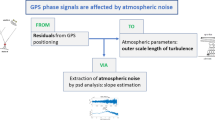Abstract
Turbulent irregularities in the lower atmosphere cause physical correlations between Global Positioning System (GPS) carrier-phase measurements. Based on turbulence theory, a variance–covariance model is developed in this paper that reflects these correlations. The main result shows that the obtained fully-populated variance–covariance matrices depend not only on the satellite-station geometry, but also on the prevailing atmospheric conditions, which are parameterised by, e.g., the von Karman spectrum of refractivity fluctuations and the wind velocity vector. It is shown that the amount of the correlation between two GPS carrier-phase observations is inversely related to the separation distance of the corresponding ray paths through the turbulent atmosphere. Furthermore, the wind velocity and direction play a key role in the correlation.
Similar content being viewed by others
References
Abramowitz M, Segun IA (eds) (1972) Handbook of mathematical functions. Dover, New York
Andrews LC, Phillips RL (1998) Laser beam propagation through random media. The International Society of Optical Engineering Press, Bellingham
Armstrong JW, Sramek RA (1982) Observations of the tropospheric phase scintillations at 5 GHz on vertical paths. Radio Sci 17(6):1579–1586
Bischoff W, Heck B, Howind J, Teusch A (2005) A procedure for testing the assumption of homoscedasticity in least-squares residuals: a case study of GPS carrier-phase observations. J Geod 78(7–8):397–404 doi:10.1007/s00190-004-0390-5
Bischoff W, Heck B, Howind J, Teusch A (2006) A procedure for estimating the variance function of linear models and for checking the appropriateness of estimated variances: a case study of GPS carrier phase observations. J Geod 79(12):694–704 doi:10.1007/s00190-006-0024-1
Beutler G, Bauersima I, Gurtner W, Rothacher M (1987) Correlations between simultaneous GPS double difference carrier phase observations in the multistation mode: Implementation considerations and first experiences. Manusc Geod 12(1):40–44
Born M, Wolf E (2003) Principles of optics electromagnetic theory of propagation, interference and diffraction of light, 7th (expanded) edn. Cambridge University Press, Cambridge
Brunner FK (1982) The effects of atmospheric turbulence on telescopic observations. Bull Géod 56(4):341–355 doi:10.1007/ BF02525733
Davis JL (1992) The effect of turbulence on atmospheric gradient parameter estimated from ground-based radiometric and space geodetic measurements. Geophys Res Lett 19(1):2183–2186
Dravskikh AF, Finkelstein AM (1979) Tropospheric limitations in phase and frequency coordinate measurements in astronomy. Astrophys Space Sci 60(2):251–265
Edwards CD (1989) The effect of spatial and temporal wet-troposphere fluctuations on connected element interferometry. TDA Progress report 42–97:47–57, Jet Propulsion Laboratory, Pasadena
El-Rabbany A (1994) The effect of physical correlations on the ambiguity resolution and accuracy estimation in GPS differential positioning. Tech Report 170, Department of Surveying Engineering, University of New Brunswick, Fredericton
Emardson TR, Jarlemark PO (1999) Atmospheric modelling in GPS analysis and its effect on the estimated geodetic parameters. J Geod 73(6):322–331 doi:10.1007/s001900050249
Hartinger H, Brunner FK (1999) Variances of GPS phase observations: the SIGMA-ɛ model. GPS Solutions 2(4):35–43 doi:10.1007/PL00012765
Howind J, Kutterer H, Heck B (1999) Impact of temporal correlations on GPS-derived relative point positions. J Geod 73(5):246–258 doi:10.1007/s001900050241
Gradinarsky LP (2002) Sensing atmospheric water vapor using radio waves. Dept. Radio and Space Science, School of Electrical Engineering, Chalmer University of Technology, Göteborg
Ishimaru A (1978) Wave propagation and scattering in random media, Vol II. Academic, New York
Stotskii AA, Elgered KG, Stotskaya IM (1998) Structure analysis of path delay variations in the neutral atmosphere. Astron Astrophys Trans 17(1):59–68
Tatarskii VI (1971) The effect of the turbulent atmosphere on wave propagation (translated from Russian by the Israel Program of Scientific Translation), Jerusalem
Taylor GI (1938) The spectrum of turbulence. Proc R S 164(A919):476–490
Tiberius C, Kenselaar F (2003) Variance component estimation and precise GPS positioning: case study. J Surv Eng 129(1):11–18 doi: 10.1061/(ASCE)0733–9453(2003)129:1(11)
Tiberius C, Jonkman N, Kenselaar F (1999) The stochastics of GPS observables. GPS World 10(2):49–54
Teunissen P, Jonkman N, Tiberius C (1998) Weighting GPS dual frequency observations: bearing the cross of cross-correlation. GPS Solutions 2(2):28–37 doi:10.1007/PL00000033
Treuhaft RN, Lanyi GE (1987) The effect of the dynamic wet troposphere on radio interferometric measurements. Radio Sci 22(2):251–265
Wang J, Satirapod C, Rizos C (2002) Stochastic assessment of GPS carrier phase measurements for precise static relative positioning. J Geod 76(2):95–104 doi:10.1007/s00190-001-0225-6
Wheelon AD (2001) Electromagnetic scintillation—I. Geometrical optics. Cambridge University Press, Cambridge
Williams S, Bock Y, Fang P (1998) Integrated satellite interferometry: tropospheric noise, GPS estimates and implication for interferometric synthetic aperture radar products. J Geophys Res 103(B11):27051–27067
Author information
Authors and Affiliations
Corresponding author
Rights and permissions
About this article
Cite this article
Schön, S., Brunner, F.K. Atmospheric turbulence theory applied to GPS carrier-phase data. J Geod 82, 47–57 (2008). https://doi.org/10.1007/s00190-007-0156-y
Received:
Accepted:
Published:
Issue Date:
DOI: https://doi.org/10.1007/s00190-007-0156-y




